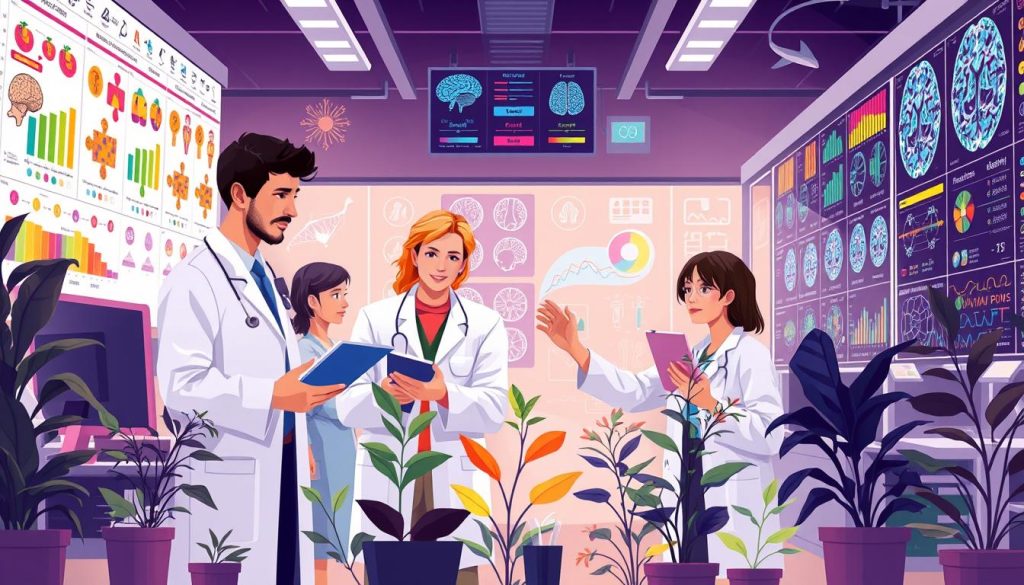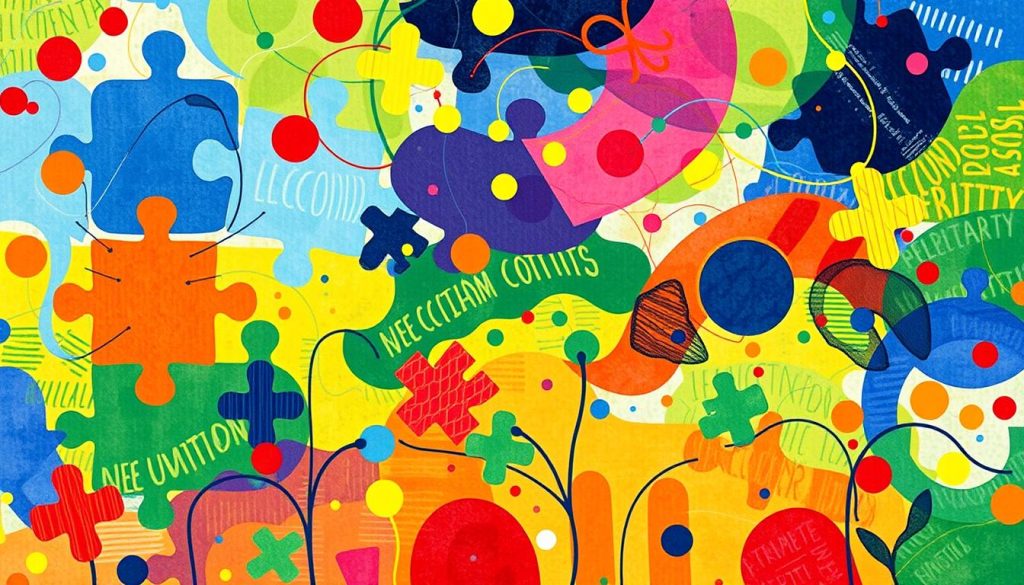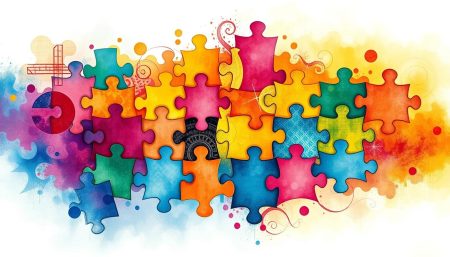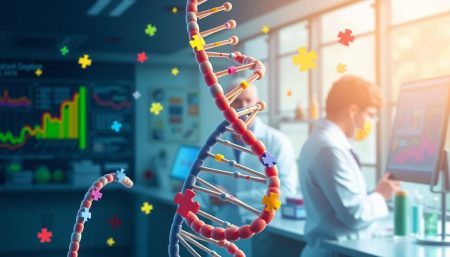The human mind is complex and shows itself in many ways, like in autism-spectrum disorders (ASD). It’s important to see the wide range of ASD diversity as we learn about the different experiences of those on this spectrum. Our journey to understand different kinds of autism-spectrum disorder starts with a broad view, supported by the Autism Society of America. They see ASD as a diverse human trait, not just a medical label.
We talk to experts like the CDC and the World Health Organization to understand autism better. By accepting autism spectrum variations, we discover the unique abilities and challenges of each person with ASD. In the U.S. and worldwide, this understanding changes how we support, accept, and empower those with ASD.
Understanding Autism Spectrum Disorders
Autism Spectrum Disorders (ASD) cover a wide range of challenges and abilities. This is why it’s called a spectrum. The term “spectrum” shows how different people with ASD can be. Knowing this spectrum helps in understanding each person’s needs for therapy and support.
What Does “Spectrum” Mean in ASD?
The spectrum of autism means different symptoms for different people. These symptoms can affect social skills, repetitive behaviors, speech, and communication. No two people with autism are alike, needing different support and interventions.
Early Signs and Diagnosis of ASD
Spotting autism early can help a lot with treatment. Signs can show up in infancy, but most diagnoses happen later. Early signs include not making eye contact, slow speech, and not wanting to play with others.
Knowing these signs helps in getting a diagnosis sooner. This can lead to better support and outcomes for those with ASD.
The Importance of Recognizing Diversity in Autism
It’s key to understand the diversity in autism spectrum disorders. This diversity helps in creating a more inclusive society for those with ASD. It also shows the need for flexible and varied treatments, education, and support.
By recognizing this diversity, we can improve educational methods, social strategies, and community inclusion. This promotes a deeper understanding and acceptance of ASD.
The Core Features of Autism Spectrum Disorders
Understanding the core features of Autism Spectrum Disorders (ASDs) is key. It helps us see the wide range of autism spectrum condition variations and autism spectrum disorder categories. At the core, ASD includes challenges with social communication, repetitive behaviors, and sensory sensitivities.
People with ASD often struggle with social interactions. They might find it hard to understand non-verbal cues like body language and facial expressions. They may also miss out on social nuances like sarcasm and humor, making it tough to connect with others.
Repetitive behaviors are another key feature of ASD. These can be seen in actions like rocking or hand-flapping. They can also involve strict routines and a dislike for change. These behaviors help individuals with ASD feel secure and in control.
Sensory sensitivities are also a big part of ASD. Some people might be too sensitive to sounds, textures, or light. This highlights the need for environments that meet their sensory needs, which can vary a lot.
Learning about these core features across different autism spectrum disorder categories helps us support those affected better. It also makes our society more inclusive of the autism spectrum.
- Social Communication Challenges
- Repetitive Behaviors
- Sensory Sensitivities
| Feature | Description | Impact on Individuals |
|---|---|---|
| Social Communication | Difficulties with non-verbal cues, social interactions, and conventional speech patterns. | May lead to social isolation and misunderstood social behaviors. |
| Repetitive Behaviors | Behaviors include rocking, hand-flapping, and adherence to routines. | Provides comfort and predictability; disruption can cause significant distress. |
| Sensory Sensitivities | Abnormal responses to sensory stimuli like sound, light, and touch. | Requires specialized environmental adjustments to reduce sensory overload. |
Different Kinds of Autism-Spectrum Disorder
Exploring autism spectrum disorders (ASDs) shows a wide range of conditions. Each has its own challenges and traits. This part looks at the different types and subtypes of autism, focusing on Asperger’s Syndrome and Childhood Disintegrative Disorder. These are two unique parts of the autism spectrum.
Autism Spectrum Subtypes
ASD includes many conditions with different levels of challenges. These challenges are in social interaction, communication, and repetitive behaviors. Knowing these subtypes helps us tailor support to meet each person’s needs.
Asperger’s Syndrome: A Unique Profile within ASD
Asperger’s Syndrome is special because it doesn’t involve a delay in language or thinking. People with Asperger’s often have deep interests and know a lot about certain topics. But, they might struggle with social interactions, not always getting social cues right.
Childhood Disintegrative Disorder and ASD
Childhood Disintegrative Disorder (CDD) is rare but severe. It affects children who lose social, communication, and motor skills after normal development. This loss makes CDD stand out as a unique and challenging part of autism spectrum diagnoses.
| Condition | Core Features | Impact on Social Skills |
|---|---|---|
| Asperger’s Syndrome | Highly focused interests, verbal proficiency | Difficulty with social cues and norms |
| Childhood Disintegrative Disorder | Normal development followed by regression | Loss of previously acquired social skills |
Understanding the differences in autism spectrum diagnoses helps us better grasp ASD diversity. This is key for providing the right and effective help.
High-Functioning vs. Low-Functioning Autism
The terms high-functioning and low-functioning autism are being questioned. They are seen as too broad and can be stigmatizing. Groups like the National Institute of Mental Health and the Autism Research Institute suggest using more precise terms.
High-functioning autism is about people who need little help and can handle daily tasks. They might speak well and seem smart, but struggle with social interactions.
On the other hand, those with low-functioning autism need a lot of help. They face big challenges in talking and doing everyday things. They often need extra support in school and at home.
| Characteristic | High-Functioning Autism | Low-Functioning Autism |
|---|---|---|
| Language Skills | Strong, with possible subtle difficulties | Limited or lacking |
| Support Needs | Minimal to moderate | Significant |
| Social Interaction | Challenges mostly in complex interactions | Severe challenges in most interactions |
While the terms high-functioning and low-functioning autism are useful, they’re not enough. They don’t fully show what people can or can’t do. Critics say these labels can lead to misunderstandings and overlook each person’s unique talents.
Many experts and advocates believe autism is a spectrum with many variations. They say we should focus on understanding each person’s needs. This way, we can offer support that really helps.
Groups like Autistica are pushing for better terms, like “autism spectrum condition.” They want to highlight the diversity and individuality of those on the spectrum. This change is important for creating a more welcoming and understanding world.
Note: Debates around terminology continue to influence how individuals understand and interact with those affected by autism spectrum variations.
Autism Spectrum Condition Variations
Exploring autism spectrum variations is key. We must understand primary symptoms and co-occurring conditions. These conditions add unique challenges and needs for each person.
Understanding the Range of Conditions
Autism variations include a range of additional conditions. Knowing these conditions helps in providing the right support. Conditions like ADHD, anxiety disorders, and sensory processing issues often occur with autism.
Co-occurring Conditions and Their Impact on Autism
Co-occurring conditions can greatly affect an individual’s life. ADHD can make communication harder, while anxiety disorders can lead to social withdrawal. Sensory processing issues can make everyday life overwhelming, requiring special adaptations.
| Condition | Impact on Autism | Common Interventions |
|---|---|---|
| ADHD | Increases impulsivity and difficulty focusing | Behavioral therapies, ADHD medications |
| Anxiety Disorders | Heightens social and environmental fears | Cognitive Behavioral Therapy, medication if necessary |
| Sensory Processing Issues | Makes sensory stimuli overwhelming, affecting behavior | Occupational therapy, sensory integration strategies |
Understanding autism variations and their co-occurring conditions is essential. It shapes therapy and support approaches. By addressing primary symptoms and additional challenges, we can better support those on the autism spectrum.
Rethinking the Classic Autism Diagnosis
Our understanding of autism has grown a lot, changing how we diagnose it worldwide. Classical autism used to mean a specific set of behaviors. Now, we see autism as a wide range of experiences. This change shows how our ways of checking for autism have evolved.
The DSM-5 from the American Psychiatric Association is a big step forward. It made the rules for diagnosing autism more open and detailed. This change came from lots of research and feedback from people with autism and their families.
Groups like Autism Speaks have also been key in changing how we see autism. They do research and speak up for better ways to diagnose autism. They help us see that classical autism is just one part of a bigger picture.
| Year | Diagnostic Criteria | View on Autism |
|---|---|---|
| Pre-1980s | Very Narrow, rigid criteria focused on severe impairments. | Autism as rare and homogeneous. |
| 1990s – DSM-IV | Broadening to include less severe forms of autism. | Introduction of Asperger’s Syndrome, recognition of spectrum. |
| 2013 – DSM-5 | Further broadened and refined, amalgamation into ASD. | Emphasis on spectrum and subtypes, including an update on what historically was classified as classical autism. |
Changing from just classical autism to Autism Spectrum Disorder is a big step. It shows we now understand autism better. This change helps us see that each person with autism is unique. It shows we need to make our diagnosis methods more flexible and personal.
ASD Classification Over Time
The way we diagnose autism spectrum disorder (ASD) has changed a lot over the years. This change comes from new research and different views in the medical field. We will look at key moments in ASD’s history and how these changes have helped us better understand and spot autism.
The Evolution of Autism Diagnoses
ASD’s history shows big changes from the start to today. At first, it was seen as a type of childhood schizophrenia. Then, in 1943, Leo Kanner gave it a clearer definition, focusing on emotional and social issues in children. The criteria for diagnosing autism have grown and changed, leading to the DSM-5.
Impact of Changes in the DSM on ASD Identification
The DSM-5 was a big change for diagnosing autism. It brought all autism types under one category, ASD. This change made how we see and treat autism more like a spectrum, with different levels of symptoms. This change is a topic of ongoing debate among doctors, researchers, and groups that support autism awareness.
| Classification | Description | DSM Edition |
|---|---|---|
| Autistic Disorder | Focus on significant language and social interaction delays. | DSM-IV-TR |
| Asperger’s Syndrome | Characterized by high functioning levels and no significant language delay. | DSM-IV-TR |
| Pervasive Developmental Disorder-Not Specified (PDD-NOS) | A more ambiguous classification for those that do not fully fit into other categories. | DSM-IV-TR |
| Autism Spectrum Disorder | Unified spectrum covering all subcategories with levels of support specified. | DSM-5 |
Types of Autism Disorders and Their Characteristics
Exploring autism, it’s key to know the different autism spectrum subtypes and their characteristics of autism. Each subtype has its own set of behaviors, cognitive abilities, and sensory sensitivities. These are important for creating personalized treatments.
The autism spectrum includes various subtypes, each with its own unique profile. These can be identified through observing behaviors and cognitive tests. Understanding these subtypes helps us meet the needs of those affected.
- Classic Autism
- Asperger’s Syndrome
- Pervasive Developmental Disorder – Not Specified (PDD-NOS)
Each subtype has its own set of characteristics, affecting people differently. For instance, those with Asperger’s Syndrome often have milder symptoms and may be more intelligent. On the other hand, classic autism can make communication and social interactions very hard.
| Autism Subtype | Common Characteristics | Sensory Sensitivities |
|---|---|---|
| Classic Autism | Significant social and communication challenges, repetitive behaviors | High |
| Asperger’s Syndrome | Higher intellectual abilities, difficulties in social interaction | Moderate |
| PDD-NOS | Varies greatly; fewer or milder symptoms than classical autism | Varies |
Knowing about the autism spectrum subtypes and characteristics of autism helps us develop better strategies for interaction and learning. It also helps us appreciate the unique ways people experience the world.
Autism Spectrum Disorder Categories
Understanding Autism Spectrum Disorder (ASD) categories is key. It involves looking at the autism diagnostic criteria and the clinical context of autism. These steps are vital for accurate diagnoses and effective treatments.
Breaking Down the Autism Diagnostic Criteria
The DSM-5 outlines the autism diagnostic criteria. It lists behaviors and symptoms needed for an ASD diagnosis. These include social communication and interaction issues, and repetitive behaviors seen in early childhood.
The Autism Diagnostic Observation Schedule (ADOS) is used for a detailed analysis. It assesses social interactions, communication, and play behaviors of those suspected of ASD.
The Context of Autism Categories in Clinical Settings
In clinics, knowing the autism categories helps tailor treatments. Clinicians use interviews and observations to apply the diagnostic criteria to each patient. This ensures treatments are specific to each person’s needs.
When classifying autism in clinics, factors like language skills, cognitive abilities, and other conditions are considered. These factors influence the type and intensity of therapy needed.
Using these tools helps create detailed profiles for ASD management. It promotes personalized care, which is essential in clinics where one approach doesn’t fit all.
| Criteria | Observations in ADOS | Relevance in Clinical Settings |
|---|---|---|
| Deficits in social communication and interaction | Assessed through simulated social interactions | Directly impacts the choice of social skills training |
| Restrictive and repetitive behaviors | Observations of play and choice activities | Guides recommendations on interventions and accommodations |
| Response to sensory input | Evaluation of reactions to various stimuli | Helps adapt the environment for sensory sensitivities |
Through detailed clinical observations and standardized tests like ADOS, ASD diagnosis and categorization become more precise. This leads to more tailored care strategies for the autism community.
Evaluating Symptoms Across the Autism Spectrum
Understanding autism spectrum diagnoses is complex. It needs a mix of strategies for good ASD symptom evaluation. Key methods include standardized tests, observing behavior, and talking to parents. Each way gives different views, helping to fully grasp the person’s situation.
Healthcare experts use standardized tests to measure autism symptoms. Observations give a closer look at how symptoms show up in different places. Parent interviews add important background info that might not be seen right away.
- Standardized tests – Used to objectively measure the symptoms against established metrics.
- Observational assessments – Focus on the individual’s behavior in various social and environmental contexts.
- Parent interviews – Offer additional insights into the individual’s development and behavior over time.
Because symptoms vary and can be different in intensity, using all these methods helps get a clearer autism spectrum diagnosis.
| Evaluation Method | Key Focus | Relevance to Diagnosis |
|---|---|---|
| Standardized Tests | Quantitative measurement | Highly applicable across all ASD cases |
| Observational Assessments | Behavior in natural settings | Crucial for understanding day-to-day challenges |
| Parent Interviews | Development history and personal insights | Valuable for contextual background |

Gender Differences in Autism Spectrum Disorders
Recent studies have highlighted gender differences in ASD. They show that autism can look different in boys and girls. The Journal of the American Academy of Child & Adolescent Psychiatry found that genetics and environment play a role. These factors might change how symptoms show up and get diagnosed.
There’s a big issue with how we diagnose autism. Current methods might not work as well for girls as they do for boys. This is because most research data comes from boys. We need new ways to diagnose that work for everyone.
- It’s important to understand these differences better.
- We need support that fits the needs of both boys and girls with ASD.
The Autism Research Institute has found that social settings affect boys and girls with ASD differently. How society expects us can change how we show autism. This shows how complex autism is and why we need different approaches in research and treatment.
We must make sure future studies include both boys and girls. This will help us understand autism better. It’s key to creating support systems that work for everyone with autism.
The Intersection of Genetics and Autism Spectrum Disorders
Understanding the genetic roots of Autism Spectrum Disorders (ASD) is key to better diagnosis and treatment. Researchers are finding out how genetics and autism are linked. They are uncovering the many genetic factors that play a role in ASD.
Hereditary Factors in ASD
Studies show that autism can be passed down in families, pointing to a genetic link. The National Institute of Genetic Medicine found that siblings of children with autism are more likely to have it too. Also, identical twins are more likely to share ASD traits than fraternal twins.
Recent Genetic Studies and Their Findings on ASD Diversity
New genetic studies on autism highlight the spectrum’s diversity. They show that autism is not the same for everyone. The Autism Genetics Resource Exchange found many genes linked to autism, each affecting people differently.
| Gene | Associated ASD Traits |
|---|---|
| SHANK3 | Language and social interaction difficulties |
| CHD8 | Gastrointestinal issues and macrocephaly |
| SYNGAP1 | Intellectual disability and epilepsy |
This variety in genetic links explains why people with ASD face different challenges. Research from genetics journals helps us understand this better. It shows we need to tailor treatments to each person’s needs.
Autism Spectrum Diagnoses: A Parent’s Perspective
Learning from parents about ASD is key to understanding autism. Families face many emotions and challenges. Each story is important for the autism community.
Sharing personal experiences is very insightful. Parents talk about their children’s needs and the help of groups like Families for Early Autism Treatment. These organizations are vital for support and guidance.
- Initial reactions to diagnosis
- Challenges in accessing support services
- Effective strategies in day-to-day management
- Success stories of support and growth
Looking into parent experiences with ASD sheds light on personal journeys. It builds empathy and understanding in society. These stories show both the struggles and victories of living with autism.
| Challenge | Support Mechanism | Outcome |
|---|---|---|
| Accepting diagnosis | Family counseling | Increased emotional coping |
| Securing educational accommodations | Advocacy groups | Enhanced learning environment |
| Navigating social challenges | Community support programs | Improved social interaction skills |
This data shows what helps families with autism. It shows how support strategies work in real life. Families across the country use these methods to improve their lives.
Therapeutic Approaches for Different Types of Autism
The field of autism therapy has grown a lot. It now offers many strategies to help people with autism learn and behave better. Behavioral treatments and autism educational programs are key. They help with skills like learning and socializing.
Behavioral and Educational Interventions
Behavioral treatments are very important. They focus on Applied Behavior Analysis (ABA). ABA helps by teaching new skills and improving behavior through rewards.
Autism educational programs are made for kids with autism. They use special teaching methods and curriculums. This helps kids learn and do well in school and with friends.
Medical and Alternative Treatments in Autism Care
There are also medical and alternative treatments for autism. These include medicines for certain problems and therapies like music or art. They help with symptoms and can teach new skills.
| Intervention Type | Goals | Examples |
|---|---|---|
| Behavioral Treatments | Improve social behavior and communication | Applied Behavior Analysis (ABA), Cognitive Behavioral Therapy (CBT) |
| Educational Programs | Promote learning and academic skills | Specialized IEPs, Inclusive Classrooms |
| Medical/Alternative Treatments | Manage symptoms, enhance well-being | Pharmacotherapy, Art Therapy |
It’s important to know how each therapy works. This helps make plans that fit each person’s needs. It helps them grow and learn more.
Advances in Research and Understanding Autism Spectrum Variations
Recent years have seen big steps forward in autism research advances. This has helped us understand the understanding autism spectrum better. It has also led to new ways to help and support people with autism.
Autism Speaks and other sources have made important contributions. They have shown us the wide range of research happening today:
- Genetic research has found new links between autism and certain genes.
- Studies have shown how early, tailored interventions can help.
- New diagnostic tools are being developed. They help diagnose autism earlier and more accurately.
| Research Area | Key Findings | Potential Impact |
|---|---|---|
| Genetic Studies | Several genes linked to ASD have been found. | This could lead to treatments that are more personal. |
| Early Intervention | Custom educational programs help ASD kids develop better. | This improves learning and behavior from a young age. |
| Technological Innovations | New neural imaging and AI tools are being developed. | These could help diagnose and treat autism sooner. |

These autism research advances are key to a future where we fully understand the understanding autism spectrum. Researchers and doctors are working hard to use this knowledge. They aim to make treatments that really help people with ASD and their families.
Living with Autism: Real Stories of ASD Diversity
The autism community is as colorful as the spectrum itself. Real-life stories show how autism affects people differently. These stories highlight both the struggles and the special talents of those on the spectrum.
For example, a young student might excel in school but find it hard to make friends. An artist might use their sensitivity to create amazing art. These stories show the wide range of experiences people with autism have.
Documentaries and interviews give us a close look at autism. They show how people with autism solve problems and see the world. They also share how people communicate in their own ways.
These stories remind us that autism is not the same for everyone. They show the need for support that fits each person’s needs. By learning from these stories, we grow to see autism as a source of strength and diversity.
FAQ
Q: What are the different kinds of autism-spectrum disorder?
A: Autism-spectrum disorder (ASD) includes several conditions like Autistic Disorder and Asperger’s Syndrome. Each person with ASD experiences it differently. The latest DSM-5 edition combines these into one term: ASD.
Q: What does “spectrum” mean in ASD?
A: “Spectrum” in ASD means a wide range of differences in skills and challenges. Some people need a lot of support, while others are very independent. It shows how diverse ASD symptoms and behaviors can be.
Q: What are the early signs and symptoms of ASD?
A: Early signs of autism include delayed speech and little eye contact. People with ASD might also have a strong preference for routines. These signs can vary a lot, which is why ASD is called a spectrum.
Q: Why is recognizing diversity in autism important?
A: Recognizing diversity in autism helps tailor diagnosis and support. Each person with ASD has unique strengths and challenges. This approach ensures better support and outcomes for them.
Q: What are core features of autism spectrum disorders?
A: Core features of ASD include challenges with social interaction and repetitive behaviors. Many also have sensory sensitivities. These features can vary a lot among individuals with ASD.
Q: Are Asperger’s Syndrome and high-functioning autism the same?
A: Asperger’s Syndrome was once seen as a separate condition. It was characterized by social challenges and repetitive behaviors without language delay. Now, it’s part of the broader ASD diagnosis in the DSM-5.
Q: What impact do co-occurring conditions have on individuals with ASD?
A: Conditions like ADHD and anxiety can affect people with ASD a lot. They can make diagnosis harder and require different support. These conditions add to the challenges faced by individuals with ASD.
Q: How has the classic autism diagnosis evolved over time?
A: Our understanding of autism has grown over time. The DSM-5 now focuses on symptoms and behaviors, not strict categories. This change reflects our growing knowledge of ASD.
Q: How have classifications of ASD changed in recent years?
A: ASD classification has changed a lot, thanks to the DSM-5. It used to have separate categories like Autistic Disorder and Asperger’s Syndrome. Now, it’s all under one category: ASD.
Q: How are symptoms evaluated across the autism spectrum?
A: Symptoms are evaluated with tools like the Autism Diagnostic Observation Schedule (ADOS). Clinicians also look at developmental history and parental interviews. This approach helps diagnose ASD accurately.
Q: Are there gender differences in how ASD presents?
A: Yes, research shows ASD can present differently in males and females. Females might show less typical autistic traits. Understanding these differences is key to proper support.
Q: Can genetics play a role in ASD?
A: Genetics are a big part of ASD. Studies have found many genetic variations linked to autism. This shows ASD is complex and involves many genes.
Q: What is a parent’s perspective on receiving an autism spectrum diagnosis for their child?
A: Getting an ASD diagnosis is a complex and emotional journey for parents. It can bring clarity and support but also challenges like navigating the healthcare system. Parents must adjust their expectations for their child’s development.
Q: What are some therapeutic approaches for different types of autism?
A: Therapies for autism include Applied Behavior Analysis (ABA) and educational programs. Some people also use medication for co-occurring conditions. Personalized therapies are becoming more common.
Q: What are recent advances in research for understanding autism spectrum variations?
A: Recent research has found genetic markers and new diagnostic tools. It also explores environmental factors that might contribute to ASD. These advances help us understand the autism spectrum better.
Q: Could you share real stories of living with different kinds of autism-spectrum disorder?
A: Real stories of living with autism highlight unique challenges and achievements. These stories offer insight, understanding, and support to others on similar paths.


















